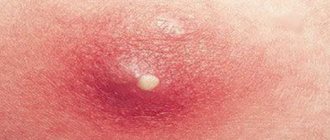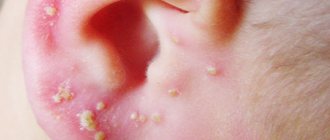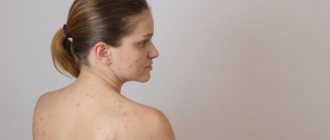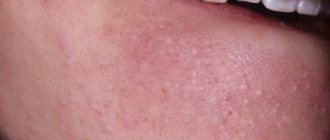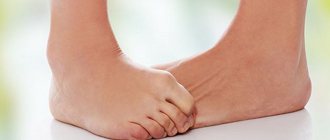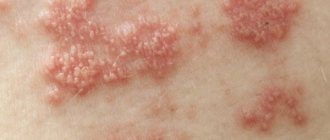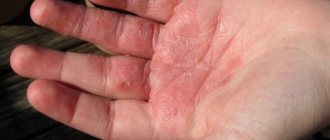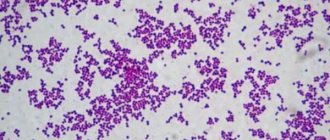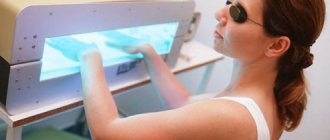Reasons for appearance
The occurrence of skin rashes that look like blisters with watery, usually transparent contents is associated with two groups of factors. They are divided into processes caused by infection with a particular infection, and non-infectious.
The most significant:
- allergy
- viral infection
- prickly heat
- hyperhidrosis
- diaper dermatitis
- scabies mite infestation
- sunburn
Most of these causes cause disease in children of any age.
How to treat watery acne in a child
If a mother notices pimples on her child’s body, it is important to consult a doctor to identify the causes of this phenomenon. Water pimples can indicate a number of problems, ranging from allergies to serious organ dysfunction, so an accurate diagnosis may require a whole range of diagnostics.
Diagnostic tests
The doctor may prescribe tests and studies after an external examination of the patient to identify the main cause of the skin rash:
- General analysis: blood, urine. They allow you to understand whether viruses or bacterial infections are present in the child’s body. This study will also describe the severity of functional impairment that occurred in a young patient;
- Biochemistry of blood. Will allow you to characterize the work of internal organs, identify dysfunction of the liver, gall bladder and kidneys;
- Inoculation of the liquid separated from the vesicle. It will help to identify the main cause of the disease that caused skin rashes;
- Allergy tests. The study is carried out if there is the slightest suspicion of an allergic reaction on the part of the child’s body to the influence of any factor. Similar tests are carried out when contacting a pediatric immunologist;
- Visual inspection of the skin. Carried out by a pediatric dermatologist to identify specific signs of a wide variety of dermatological pathologies that manifest themselves with watery pimples on the skin of children;
- Dermatoscopy. A pediatric dermatologist performs this procedure using a special device to carefully analyze all layers of the skin. Dermatoscopy is carried out for the purpose of differential diagnosis of many pathologies of a dermatological nature.
In complex clinical situations, a qualified doctor will refer you for consultation to specialized specialists if the cause of the problem is a certain chronic disease of one or more internal organs. Certain pathologies that can be transmitted through contact with other people need to be treated by an infectious disease specialist.
Treatment options
Treatment of skin rashes in children and adolescents should be selected individually, taking into account the causes of the rash identified during diagnostic tests. A qualified doctor will select medications and indicate a regimen for taking them.
The main methods of drug therapy are:
- Antiviral medications. Prescribed for herpetic lesions of the skin. For example, Acyclovir or Panavir;
- Antihistamines. Accepted in the presence of allergies, taking into account the degree of its severity. These can be: external ointments, tablets, capsules, drops for oral administration. In this case, Suprastin or Tavegil are used;
- Hormones. Drugs in this group are represented by oral tablets and ointments. For example, Elokom or Advantan;
- Itching and burning will be eliminated by Panavir gel or Bonafton ointment. The healing of blisters and the restoration of the regenerative properties of the skin in chickenpox are facilitated by the following drugs: Calamine, Tsindol, zinc ointment. Sulfur ointment, benzyl benzonate, etc. will eliminate scabies mites.
On a note! In some cases, for example, with prickly heat or dermatitis in babies, it is enough to provide the child’s skin with appropriate care and provide air access to the area affected by the rash. Then the problem will go away by itself.
Manifestations on the skin and effects on the entire body
Miliaria occurs more often in infants. It is associated with the imperfection of the sweating system during this period. The resulting sweat does not have the opportunity to naturally evaporate from the surface of the skin. Occurs when there is an excess amount of clothing, insufficient “breathing” properties, poor ventilation of the room and high temperature. It is detected in places where the body comes into contact with diapers and underwear.
Diaper dermatitis is also common in younger people. Develops with infrequent diaper changes. Caused by prolonged contact of skin and natural secretions. It mostly affects the buttocks and thighs, but in advanced cases it can spread throughout the body.
Hyperhidrosis is associated with blockage of the sweat glands by viscous secretions due to changes in the properties of sweat. The occurrence of this pathology is possible in different age categories.
Allergies can be to food products from a child's or mother's (when feeding a baby) diet, hygiene products for the care of mucous membranes and skin, washing powder or soap, house dust, plant pollen, down and feathers of birds, and pet hair.
Viral diseases that cause an infectious process, which results in, among other manifestations, watery pimples on the child’s hands include chickenpox (chickenpox), herpetic infection, and molluscum contagiosum. These diseases are manifested by an increase in temperature, a sharp deterioration in the condition and, at the slightest suspicion of their occurrence, require urgent consultation with a doctor.
When infected with scabies mites, rashes develop as a result of the body's allergic reaction to the toxins released by the pathogen. As a rule, they are accompanied by severe itching.
Sunburn is possible if you stay in the open sun for too long without using protective creams. Damaged skin turns red, and sometimes body temperature rises. In more serious cases, bubbles with liquid contents appear.
A watery rash is most often found:
- on the body
- limbs
These parts of the body should be examined first. Less commonly, the rash appears on the face, as well as the neck and scalp.
If there is itching, scratching, or skin damage due to illness, a secondary infection (bacterial) may occur, with a change in the nature of the fluid in the vesicle cavity. Purulent rashes develop, the manifestations of the disease change, body temperature rises, and health worsens. In this case, you should consult your doctor. It is necessary to prescribe antibacterial drugs.
What do small and large watery pimples on the skin in children mean?
Often, watery pimples that appear on a child’s body look like tubercles with a tiny head. Its internal contents are liquid, cloudy in color or completely transparent. It cannot be confused in appearance with the purulent contents of other types of acne.
Rashes on the skin of children can vary in size and intensity: you may notice small, individually located rashes or large pimples that merge into voluminous red spots. The larger the volume of skin covered by the rash, the more difficult it is to deal with the problem.
Treatment of urticaria, exanthema, and rashes on the skin of children should begin as quickly as possible so that the problem can be eliminated without complications. Otherwise, therapy may take several months.
The problem occurs in patients of different ages: in children of the first year of life, schoolchildren or teenagers. But the causes of the rash must be determined individually in each individual case, and treatment must be selected taking into account the age of the child.
In young children, rashes can be observed more often, since the physiological structure of the child’s skin does not allow him to withstand many negative environmental factors.
Due to the baby’s still weak immunity, watery blisters that appear on his skin tend to spread quite quickly throughout the body.
Reasons that provoke the appearance of a rash on the skin of children:
- food allergies;
- pemphigus;
- dermatitis: contact, diaper;
- impetigo caused by staphylococcus;
- infectious diseases, including viral and bacterial;
- heat rash due to hot weather and tight clothing;
- eczema;
- molluscum contagiosum;
- herpes virus;
- scabies;
- diseases of the endocrine system;
- diseases of internal organs of a chronic nature.
Some bacterial pathologies of the skin are accompanied by a blistering rash. Pus appears inside the blisters, which indicates that the infection has re-entered the child’s body. The bubbles turn yellow and greenish.
Purulent rashes on the child’s skin should alert the mother, because this is direct evidence of the presence of an infectious disease in her child’s body. The situation is extremely difficult and unfavorable for the child’s health, and therefore requires immediate contact with a specialized specialist in a medical institution.
Also, such a rash may be accompanied by other symptoms:
- increased dryness, peeling, redness of the skin;
- development of the inflammatory process on the skin;
- the appearance of a large number of dense dry crusts and ulcers that do not heal for a long time;
- low skin regenerative ability.
The course and severity of adverse symptoms may vary between patients. This fact is influenced by many factors, including:
- patient's age;
- the presence of pathologies of internal organs;
- state of immunity.
Dr. Komarovsky will tell you more about the causes of childhood rash.
Parents' tactics
If a watery rash is detected on any part of the skin, it is necessary to consult a doctor as quickly as possible, especially if the rash occurs simultaneously or slightly later than an increase in body temperature and a deterioration in general condition and well-being.
Before visiting a doctor you must:
- limit contact with other children until the cause of the rash is determined
- exclude aggressive and allergy-causing foods from the diet
- observe the rules of hygiene, care, wakefulness and sleep patterns
- wash the child’s linen and clothes with hypoallergenic powders or laundry soap
- Preserve the integrity of the lesions as much as possible
- refrain from self-medication
Squeezing out the purulent contents of the blisters, scratching with destruction of their surface causes the process to spread throughout the skin, which aggravates the situation and can lead to damage to internal organs.
If the condition is severely disturbed, then it is necessary to call an ambulance.
Following a rational diet with the exception of fried, smoked foods, preservatives and the absence of allergenic foods (red vegetables and berries, citrus fruits, chocolate, coffee) allows not only to reduce the manifestations of the reaction to the allergen, but also to improve the functioning of the digestive organs. All this contributes to a speedy recovery.
Subsequently, the doctor establishes a diagnosis, determines the conditions of therapy (home or hospital), and selects medications. If the process does not require special treatment, only correction of care or diet is necessary, then under the supervision of a doctor all necessary measures are taken to quickly normalize the condition.
What does itching mean?
If the formation of watery pimples on the hands is accompanied by a feeling of itching, the following pathologies can be suspected:
- Mycosis caused by certain types of fungi. Provoking factors can be dermatophytes, saprophytes, and yeast microorganisms. Most often, fungi affect the epithelium and nail plates.
- Scabies. This disease is accompanied by the formation of many small pimples that are very itchy. First, the area between the fingers suffers, then the infectious disease affects the entire skin of the hands and torso.
- Allergic reactions. They can arise due to the influence of internal and external stimuli. The cause of discomfort can be cosmetics, medications, food, and household chemicals.
- Eczema. In this case, the weeping rash affects the fingers. This process is accompanied by severe itching.
- Neurodermatitis. This pathology is characterized by skin lesions in the elbow area.
Prevention
To avoid problems, you need to follow a number of recommendations:
- Have a full rest. Stress can be a consequence of normal lack of sleep. Normally, a person should sleep at least 8 hours a day.
- Avoid stress. If this fails, doctors recommend mastering relaxation techniques.
- Eat right, control your bowels. The basis of the diet should be healthy food that contains a large amount of vitamins.
- Use rubber gloves when in contact with household chemicals. Don't neglect hand hygiene either.
- Sunbathe. Exposure to ultraviolet radiation can help get rid of watery acne on your hands.
- Exfoliate your hands. It is important to consider that during the presence of rashes, this procedure is strictly prohibited. When the skin is cleared of acne, you can exfoliate with sea salt. This product should be applied to the steamed dermis, massage lightly, and then rinse with warm water.

